Bosch DKE9305AUC/03, DKE9305AUC/02 Owner’s Manual
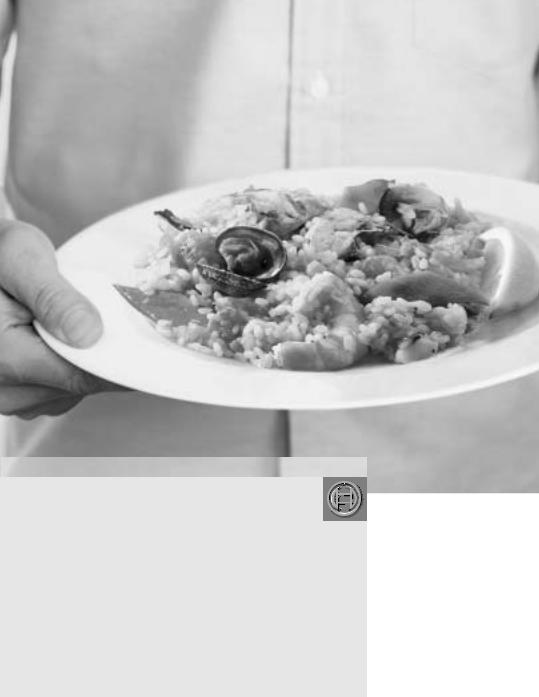
DKE 93 . . AUC
en Operating and installation instructions
fr Notice de montage et d’utilisation
es Instrucciones de uso y montaje
Internet: http://www.bosch-hausgeraete.de
Bosch Info-Team: de Tel. 01 80/5 30 40 50 (E 0,12/Min. DTAG)
a
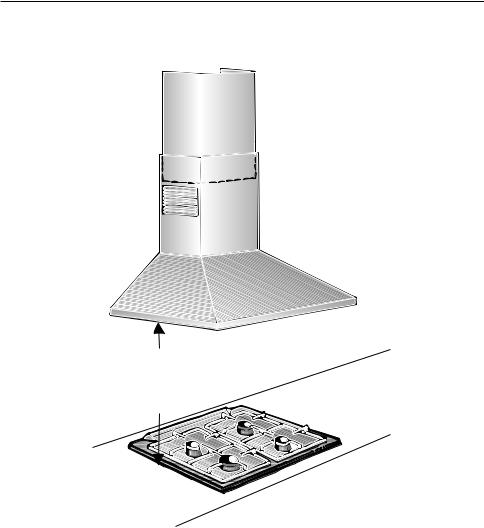
en
fr
es
page |
03 – 11 |
page |
12 – 20 |
página |
21 – 29 |
Fig. 1
MIN.30”
2
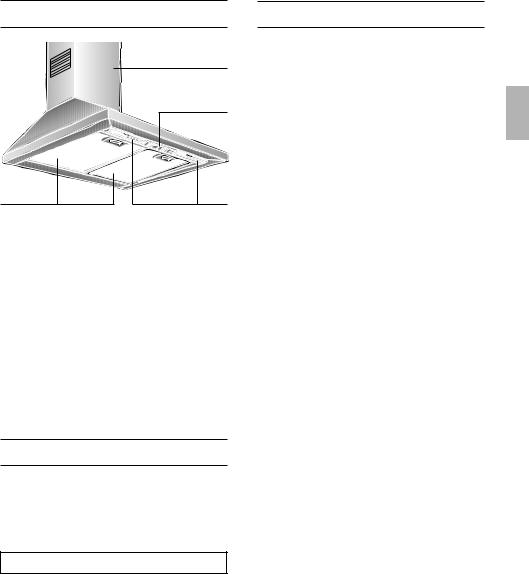
Instructions for use:
Appliance description
Chimney cover
Light / fan switches
Filter grill |
Lighting |
If you encounter a problem
If you have any questions or if a fault occurs, please call Customer Service:
1-800-735-4328
When you call, please quote the following:
E-Nr. FD
Enter the relevant numbers into the box above. The E-Nr. (product no.) and FD (production date) are shown on the nameplate which can be seen inside the extractor hood after the filter frame has been detached.
Operation
The hood fan extracts the kitchen vapours and conveys them through the grease filter into the atmosphere.
The grease filter absorbs the solid particles in the kitchen vapors.
The kitchen is kept almost free of grease and odors.
DIf the hood is in exhaust-air mode and a flue-type heater is running at the same time (e.g. gas, oil or solid-fuel heaters, continuous-flow heaters, water heaters), ensure that the fireplace has an adequate air supply for combustion.
Safe operation requires that the low air pressure in the room in which the fireplace is located does not exceed 4 Pa (0.04 mbar).
This low air pressure can be obtained, provided combustion air can escape through non-lockable openings, e.g. in doors, windows, air-intake/exhaust-air wall boxes or by other technical procedures, such as reciprocal interlocking, etc.
An air-intake/exhaust-air wall box by itself is no guarantee that the limiting value will not be exceeded.
Note: When assessing the air pressure, the entire ventilation system in the house/ apartment must be taken into account. If using cooking appliances, e.g. hob and/or gas cooker, this rule does not apply.
Government regulations must be observed for the conveyance of exhaust air.
3

Before using for the first time
Important notes:
The Instructions for Use apply to several versions of this appliance. Accordingly, you may find descriptions of individual features that do not apply to your specific appliance.
This hood complies with all relevant safety regulations.
Repairs should only be carried out by qualified technicians.
Improperly executed repairs can give rise to significant hazards for the user.
Before using your new appliance, please read these Instructions for Use carefully. They contain important information concerning your personal safety as well as on use and care of the appliance.
Please keep the operating and installation instructions in a safe place; this important documentation may also be of use to a possible subsequent owner.
Do not use the appliance if it is damaged in any way
The appliance is not intended for use by young children without supervision. Young children should be supervised to ensure they do not play with the appliance.
Electrical connections should be made by a qualified technician.
Dispose of packaging materials properly (see Installation instructions).
Light bulbs must always be fitted when the hood is in use.
Never operate the hood without a
grease filter.
fire.
If you are cooking with fat or oil, e.g. chips, etc., never leave food unattended.
Do not flambé food directly under the hood.
! Risk of grease filter catching fire due to flames.
WARNING – TO REDUCE THE RISK OF INJURY TO PERSONS, IN THE EVENT OF A RANGE TOP GREASE FIRE, OBSERVE THE FOLLOWING:
SMOTHER FLAMES with a close-fitting lid, cookie sheet, or other metal tray, then turn off the gas burner or the electric element. BE CAREFUL TO PREVENT BURNS. If the flames do not go out immediately, EVACUATE AND CALL THE FIRE DEPARTMENT
NEVER PICH UP A FLAMING PAN – you may be burned.
DO NOT USE WATER, including wet dishclothes or towels – a violent steam explosion may result.
Use an extinguisher ONLY if:
1.You know you have a class ABC extinguisher, and you already know how to operate it.
2.The fire is small and contained in the area where it started.
3.The fire department is being called.
4.You can fight the fire with your back to an exit,
4
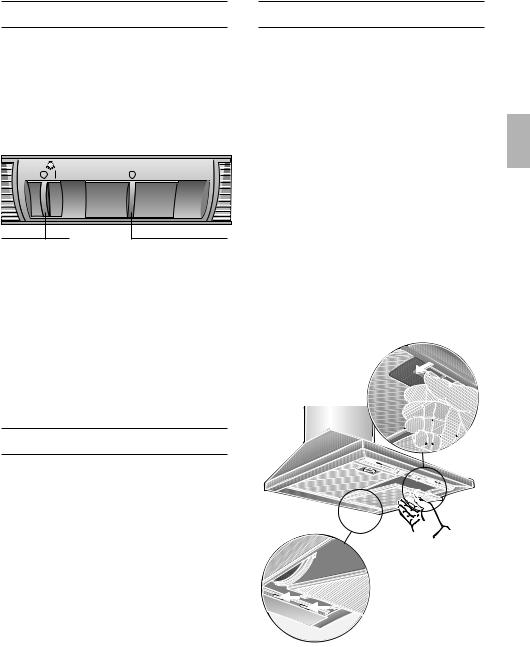
Operating procedure
The most effective method of removing vapours produced during cooking is to:
Switch the ventilator ON approximately 5 minutes before you begin cooking.
Switch the ventilator OFF
a few minutes after you have finished cooking.
1 2 3
Light Off/On |
Ventilator settings |
Switching ON:
Slide the right slide switch to the desired fan setting.
Switching OFF:
Slide the right slide switch back to 0.
Lighting:
The light can be switched on at any time, even though the fan is switched off.
Filters and maintenance
Grease filters:
Metal filters are used to trap the grease particles of the vapours that develop during cooking.
The filter mats are made from noncombustible metal.
Caution:
As the filter becomes more and more saturated with grease, not only does the risk of it catching fire increase but the efficiency of the hood can also be adversely affected.
Important:
By cleaning the metal grease filters at appropriate intervals, the possibility of them catching fire as a result of a build-up of heat such as occurs when deep-fat frying or roasting is taking place, is reduced.
Filters and maintenance
Cleaning the metal grease filters:
In normal operation (1 to 2 hours daily), the metal grease filter must be cleaned after 8 to 10 weeks.
The filters can be cleaned in a dishwasher. It is however possible that they will become slightly discolored.
Important:
Metal filters that are saturated with grease should not be washed together with other dishes etc.
When cleaning the filters by hand, soak them in hot soapy water first of all. Then brush the filters clean, rinse them thoroughly and leave the water to drain off.
Removing and inserting the metal grease filters:
1.Press the catch on the grease filters inwards and fold the filters down.
2.Clean the filters.
3.Insert the clean filters back into the hood.
5
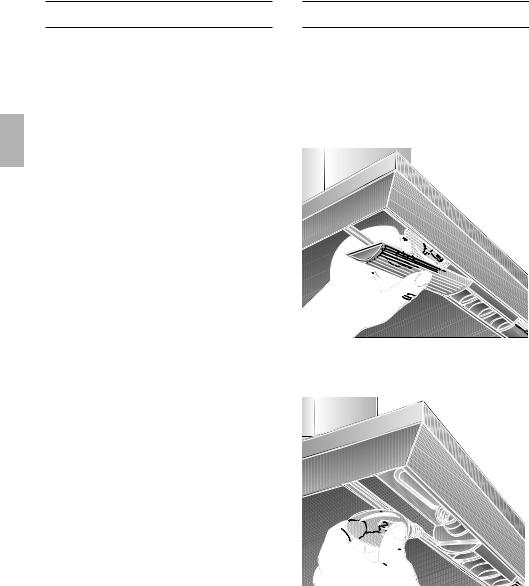
Cleaning and care
Disconnect the hood from the electricity supply by pulling out the AC plug or switching it off at the fuse box.
At the same time as you clean the grease filters, clean off any grease from all accessible parts of the housing. This significantly reduces the fire hazard and ensures that the hood performs as effectively as possible.
Use a hot detergent solution or a mild window cleaner to clean the canopy of the hood.
Do not scrape off any dirt that has dried on but loosen it up with a damp cloth.
Do not use abrasive cleaning agents or sponges that could cause scratches.
Note: Do not use alcohol (spirit) on plastic parts, otherwise the surface may lose its glass.
Caution: Ensure that the kitchen is adequately ventilated.
Clean the sliding switch with a soft, damp cloth (mild detergent solution) only. Do not use stainless steel polish on the sliding switch.
Stainless steel surfaces:
Use a mild non-abrasive stainless steel cleaner.
Clean the surface in the same direction as it has been ground and polished.
Do not use any of the following to clean stainless steel surfaces: abrasive sponges, cleaning agents containing sand, soda, acid or chloride!
Replacing the light bulbs
1.Switch off the hood and pull out the mains plug or switch off the electricity supply at the fuse box.
2.Remove the grease filters (see Filters and Maintenance).
3.Press down the bulb cover and disconnect from the light strip.
4.Replace the light bulb (commercially available candle bulbs, max. 40 watt, E12 base).
5.Attach the lamp cover again.
6.Re-insert the grease filters.
7.Plug the appliance into the mains or switch it on at the fuse box.
6

Installation Instructions:
Important information
Suitable for use in residential cooking area.
Always mount the hood over the center of the cooking surface.
Distance between cooking surface and bottom edge of hood. Should be min 30” (Fig. 1).
Additional notes concerning cooking appliances:
The relevant regulations and installation notes provided by the manufacturer of the gas cooker must be observed in all cases.
The hood may be installed next to only one full-height cupboard or high wall. Gap to be at least 2”.
The installation of the hood above gas cooking devices, at a minimum height of 30” – Fig. 1 – is permitted provided that the following
nominal heat loads (Hs) are not exceeded:
Gas cooktops |
|
Load of one burner |
max. 04,5 kW |
Load of all burners |
max. 14,1 kW |
Gas glass-ceramic cooktop
The data on nominal heat loads do not apply to gas glass-ceramic hotplates. Be sure to observe the instructions provided by the manufacturer of the hotplate.
Always turn hood ON when cooking at high heat.
Burners should not be operated without an appropriate cooking vessel in place over the burners.
Your hood has a thermal overload which will automatically shut off the motor if it becomes overheated. The motor will restart when it cools down. If the motor continues to shut off and restart, please have the hood serviced.
The smaller the gap between hood and cooking appliance, the greater the likelihood that rising steam will cause condensation to form on the hood.
7
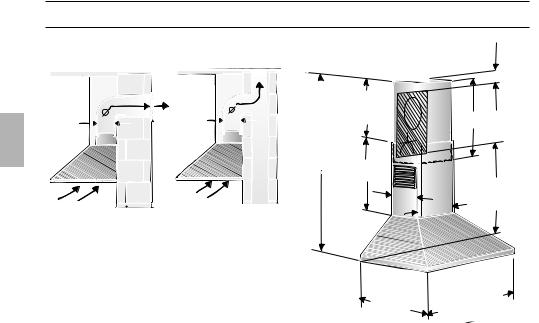
Prior to installation
Exhaust-air mode
|
. |
MIN |
|
|
8” |
2 / |
|
1 |
|
MIN.
6” |
6” |
11/4” |
18 |
5 |
8” |
|
|
|
/ |
||
|
|
MAX.455/8” |
|
|
|
|
|
MIN. 29” |
|
|
|
|
|
181/2” |
|
|
|
|
|
|
65/8” |
|
195/8” |
|
|
|
9 7/8” |
|
|
The exhaust air is discharged upwards through a ventilation duct or directly through the outside wall into the open.
DExhaust air should neither be directed into a smoke or exhaust flue that is currently used for other purposes, nor into a shaft that is used for ventilating rooms in which stoves or fireplaces are also located.
Exhaust air may be discharged in accordance with official and statutory regulations only (e.g. national building regulations).
Local authority regulations must be observed when discharging air into smoke or exhaust flues that are not otherwise in use.
Sufficient air is needed for proper combustion and exhausting of gases through the flue (chimney) of fuel burning equipment to prevent backdrafting. Follow the heating equipment manufacturers guideline and safety standards such as those published by the National Fire Protection Association (NFPA), the American Society for Heating, Refrigeration and Air Conditioning Engineers (ASHRAE), and the local code authorities.
19 |
5 |
30” |
|
/8” |
Note: When assessing the overall requirement, the combined ventilation system for the entire household must be taken into consideration. This rule does not apply to the use of cooking appliances, such as hobs and ovens.
All legal requirements concerning the discharge of exhaust air must be observed.
Due to size and weight of this unit two installers are recommended.
When cutting or drilling into wall or ceiling, do not damage electrical wiring and other hidden utilities.
To properly exhaust air, be sure to duct air outside – do not vent exhaust air into spaces within walls, ceilings, attics, crawl spaces, or garages.
WARNING – TO REDUCE THE RISK OF FIRE, USE ONLY METAL DUCT WORK.
Install this hood in accordance with all requirements specified.
8
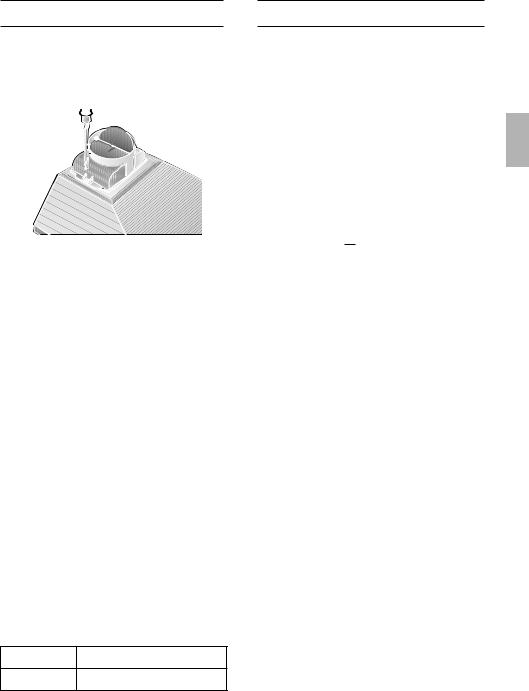
Prior to installation
The two lightly sprung flaps must be able to move upwards
If the exhaust air is going to be discharged into the open, a telescopic wall box should be fitted into the outside wall.
For optimum hood efficiency:
Short, smooth air exhaust duct.
As few bends in the duct run as possible.
Diameter of duct to be as large as possible and no tight bends in duct run.
Round pipes:
We recommend Internal diameter: 6”.
Flat ducts must have an internal crosssection that equates to that of round pipes.
There should be no sharp bends. minimum 31/4” x 10” recommended.
If pipes have different diameters:
Insert appropriate transition pieces.
Always ensure that there is an adequate supply of fresh air.
Connecting a l 6” exhaust-air pipe:
Mount the pipe directly onto the air outlet on the hood.
Preparing the wall
The wall must be flat and perpendicular.
Ensure that the wall is capable of providing a firm hold for mounting screws and plugs.
Weight in lbs:
30” 28
36” 31
We reserve the right to change specifications or design without prior notice.
Electrical connection
WARNING: THIS APPLIANCE MUST BE CONNECTED TO GROUND
IMPORTANT: Fitting a Different Plug:
The wires in the power lead are coloured in accordance with the following code:
Green |
– |
Ground |
White |
– |
Neutral |
Black |
– |
Live |
If you fit your own plug, the colours of these wires may not correspond with the identifying marks on the plug terminals.
This is what you have to do:
1.Connect the green (Ground) wire to the terminal in the plug marked ‘E’ or with the symbol (  ).
).
2.Connect the white (Neutral) wire to the terminal in the plug marked ‘N’.
3.Connect the black (Live) wire to the terminal marked ‘L’.
The hood should only be connected to an earthed socket that has been installed according to relevant
regulations.
If possible, site the earthed socket directly behind the chimney panelling.
Electrical data:
Are to be found on the name plate inside the appliance after removal of the filter frame.
Before undertaking any repairs, always disconnect the hood from the electricity supply.
Length of the connecting cable: 4 ft.
If it is necessary to wire the hood directly into the mains:
The hood should only be connected to the electricity supply by a properly qualified electrician.
A separator must be installed in the household circuit. A suitable separator is a switch that has a contact gap of more than 3 mm and interrupts all poles. Such devices include circuit breakers and contactors.
If the connecting cable for this appliance is damaged, the cable must be replaced by the manufacturer or his customer service or a similarly qualified person in order to prevent serious injury to the user.
9
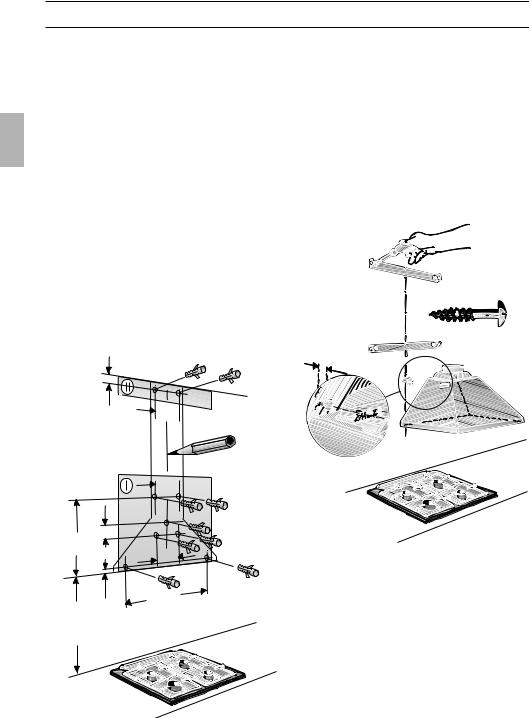
Installation
This hood is intended to be mounted onto the kitchen wall.
1.Remove the grease filter (see operating instructions).
2.Draw a line on the wall from the ceiling to the lower edge of the hood at the center of the location where the hood is going to be mounted.
3.Using the template, mark positions on the wall for the screws.
Ensure that the minimum distance between the cooking surface and the hood is maintained. The bottom edge of the template equates to the lower edge of the hood.
4.Drill 5 holes (dia. 1/4”) for the hood and 4 holes (dia. 1/4”) for the
brackets for fixing the flue ducts and insert wall plugs flush with the wall.
Note: At least one screw must be installed through a stud.
11/16”
9” 
9” 
18 |
25/8” |
|
|
|
|
1/4” |
1 |
5 |
|
||
|
4 |
/2” |
8 |
/8” |
|
|
|
11/5” |
|
|
” |
|
|
|
|
/4 |
|
|
|
|
3 |
|
|
|
|
|
15 |
|
|
MIN.30”
Note: Take into account any special accessories that are going to be fitted.
5.Screw on the 2 brackets for fixing the upper and lower flue ducts.
6.In order to help fix the hood onto the wall, screw in the middle screw (without a washer) until it protrudes by approx. 1/4”.
7.Hook the hood over the screw in the wall.
CA. 7/32”
10
